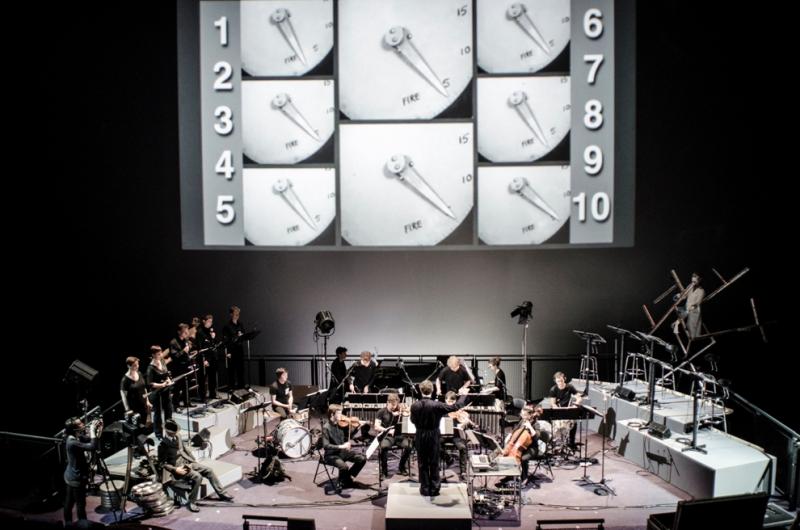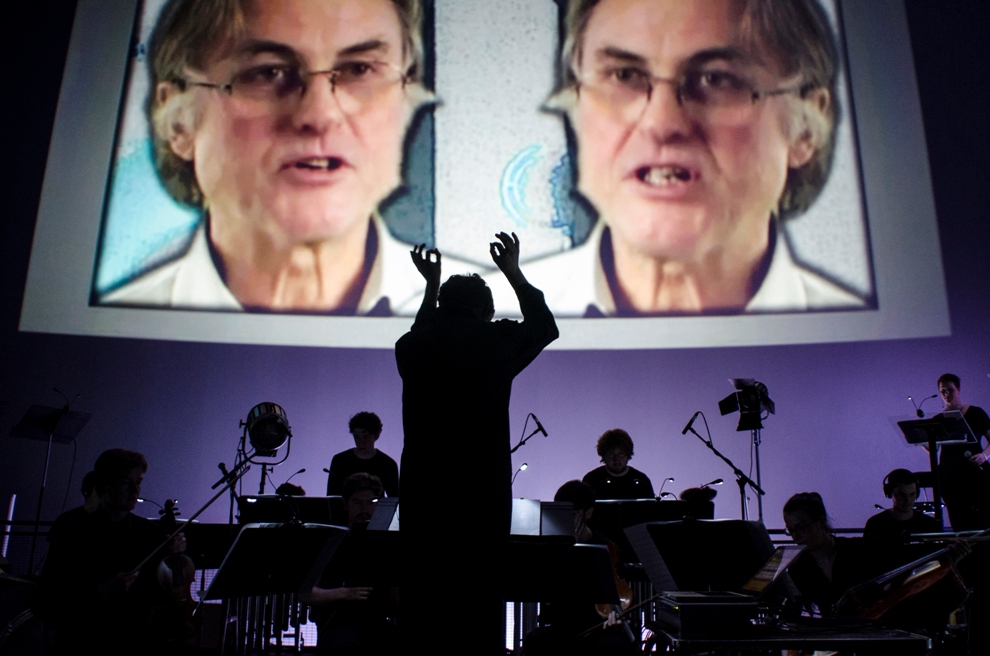Three Tales, Ensemble BPM, IMAX Science Museum | reviews, news & interviews
Three Tales, Ensemble BPM, IMAX Science Museum
Three Tales, Ensemble BPM, IMAX Science Museum
Reich and Korot's dynamic reflections on 'progress' get new life from a young ensemble

Poised vibrantly enough between the buried-alive monotony of Philip Glass and the dynamic flights of John Adams, Steve Reich’s Three Tales deserves a special place in music-theatre history ("opera" it is not).
Besides, after the pioneering speech-melodies of Different Trains and the high para-operatic showcase of The Cave, asking Jews, Muslims and contemporary Americans what the story of Ishmael means to them, Three Tales can seem like more of the same.Still, it’s worth seeing – I caught the work-in-progress at the Barbican, but not the first full performance there – so kudos to the pioneering young group Ensemble BPM for keeping it alive.
 Last night’s screening was a special case. Wandering what seemed like the infinite length of the Science Museum, past spacecraft and Stevenson’s Rocket, we arrived at the west-end extension where the IMAX Theatre is located to be lectured, interestingly enough, on the context. This was, it turned out, the very centenary day of the first use of poison gas in the First World War (and the first non-progress of the scientific century). Down the corridor was a sweater made from the fleece of Dolly the cloned sheep – subject of Reich and Korot’s third “act” – and knitted by a 12 year old who became, if only for a day, an instant media celebrity; next to it, stuffed, stands one of Dolly’s “mothers”.
Last night’s screening was a special case. Wandering what seemed like the infinite length of the Science Museum, past spacecraft and Stevenson’s Rocket, we arrived at the west-end extension where the IMAX Theatre is located to be lectured, interestingly enough, on the context. This was, it turned out, the very centenary day of the first use of poison gas in the First World War (and the first non-progress of the scientific century). Down the corridor was a sweater made from the fleece of Dolly the cloned sheep – subject of Reich and Korot’s third “act” – and knitted by a 12 year old who became, if only for a day, an instant media celebrity; next to it, stuffed, stands one of Dolly’s “mothers”.
Subject to a herding which recalled another of the 20th century’s less noble developments, mass air travel, we were then escalatored up to the IMAX to find ourselves confronted with the first of the big air crashes which now seem both familiar and yet, each time, so strange and horrifying. "Hindenburg" is the least layered and dynamic of Reich and Korot’s three “acts”, a meditation around the zeppelin disaster of 1937 in which the sampled voices of chaos, looming out of the centre of the cinema, were more unsettling than the musical textures. The anvil “chorus” which is the most striking sound in the piece comes, of course, from Wagner’s Nibelung hammering away in the interludes of Das Rheingold. There was uneasy close harmony here from the men of Synergy Vocals, a group so consummate that without a score I can only assume the sour tuning deliberate. Later the full group delivered spot-on "commentary".
"Bikini" is more counterpointed in its collage than "Hindenburg". Percussion, tuned and otherwise, flash back the rhythms of that questionable passage in Genesis quoted onscreen about man’s dominion over the other creatures who share the planet. Stalled countdowns to the tests of the 1940s and 50s, too telescoped to have anything like the cumulative impact in the last half-hour of Adams’s Doctor Atomic, pop up between poignant shots of the atoll inhabitants going about their daily life and being shipped off, never to return; the Ligeti String Quartet – not ideally bittersweet when they needed to be, owing perhaps to the miking – had the role of witnesses to the Bikinians' extraordinary plight, while the melodies reflecting the patterns of human speech, Reich’s rekindling of a vital skill honed earlier by Janáček - took on a special flavour on Valerie Welbanks’s lone cello in "Dolly".
 Here the talking heads musicalised and dissected bring us closer to the quick-change brilliance of The Cave’s Part Three, and as in that polyphony of Americana, Reich and Korot inject a passing wit and humour. The voices state the pros and cons of robotisation – a no-brainer, surely, machines will not replace the human, though as one speaker thoughtfully puts it, they may end up inside us – and Richard Dawkins (pictured above at last night's performance), whether intentionally or not, ends up as the villain of the piece with the insistence the sampling lends to his assertion that “we, and all other animals, are machines”.
Here the talking heads musicalised and dissected bring us closer to the quick-change brilliance of The Cave’s Part Three, and as in that polyphony of Americana, Reich and Korot inject a passing wit and humour. The voices state the pros and cons of robotisation – a no-brainer, surely, machines will not replace the human, though as one speaker thoughtfully puts it, they may end up inside us – and Richard Dawkins (pictured above at last night's performance), whether intentionally or not, ends up as the villain of the piece with the insistence the sampling lends to his assertion that “we, and all other animals, are machines”.
Oddly, the miracle of timing from Ensemble BPM and its musical director Nick Sutcliffe – even if the ensemble could have been even sharper at times – only got a lukewarm applause from a slightly dazed and mostly young audience (way too much texting going on as the performance progressed). One drawback could be ignored: the mannequin additions either side of the stage brought nothing to a dramatization in which screen, instruments and voices should be enough.The other, grainy projection on a giant screen for which Korot's work was never intended, may have left her artistry looking more dated than it actually is. I may not have left stunned, but last night I did have my worst nightmare ever about mass destruction. So something about Reich’s persuasive suspensions and dissonances must have inscaped the subject matter.
rating
Share this article
The future of Arts Journalism
You can stop theartsdesk.com closing!
We urgently need financing to survive. Our fundraising drive has thus far raised £49,000 but we need to reach £100,000 or we will be forced to close. Please contribute here: https://gofund.me/c3f6033d
And if you can forward this information to anyone who might assist, we’d be grateful.

Subscribe to theartsdesk.com
Thank you for continuing to read our work on theartsdesk.com. For unlimited access to every article in its entirety, including our archive of more than 15,000 pieces, we're asking for £5 per month or £40 per year. We feel it's a very good deal, and hope you do too.
To take a subscription now simply click here.
And if you're looking for that extra gift for a friend or family member, why not treat them to a theartsdesk.com gift subscription?

Add comment